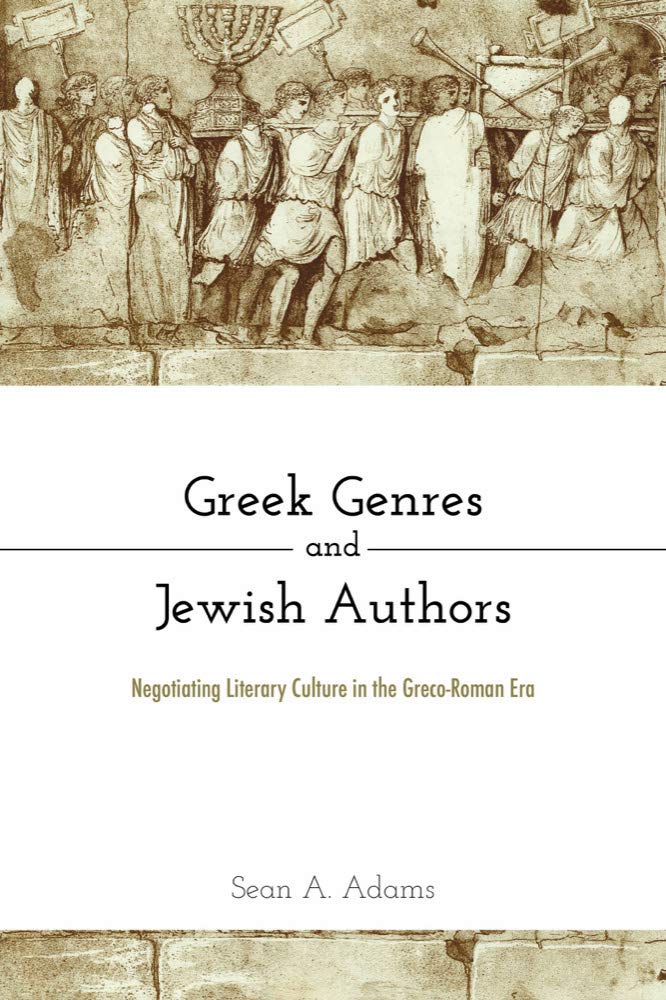A review of Sean Adams’ Greek Genres and Jewish Authors

This excellent study does exactly what it says it will do: explore the way Jewish authors used and adapted Greek genres of writing between 300 BC and AD 135. Dr Sean Adams shows an astonishing and impressive breadth of engagement with the primary sources for this period, and has put us in his debt by his careful and thoughtful analysis. Dr Adams’ doctoral project considered the genre of the NT book of Acts, arguing that it bears significant similarities to the genre of collected biography; here he extends his analysis of genre helpfully and engagingly.
A key question, of course, is what he considers ‘genre’ to be, and his explanation here is limpidly clear and opens up discussion in very helpful ways. Uncontroversially, he considers genre to provide a framework which enables readers to read a text appropriately, and which distinguishes it from other kinds of texts. New to me (others may have known this for a long time, of course) is the idea that a text ‘participates’ in a genre, rather than belonging to it (9)—thus texts can participate in the same genre but come from very different geographical, historical and rhetorical settings. Genres, on this model, are flexible, and can and do change according to time and location. Such fluidity means tidy and hermetically sealed boundaries between genres are inappropriate. Dr Adams draws on prototype genre theory to signal that a given literary genre is flexible and can be adapted, while still having the prototypical features of that genre. A given text can thus participate in more than one genre.
His opening chapter closes by summarising six key claims which the book will make (18): (i) Jewish authors writing in Greek use and adapt Greek genres which shape their writing; (ii) practices and preferences for such writing varied over time; (iii) Jewish authors preferred some genres more than others, especially history, and their choices relate to the text’s purpose and audience; (iv) using Greek genres implies the author has a certain level of Greek education and access to sources; (v) educational practices varied according to time and place; (vi) choices of genre and style of composition illuminate our understanding of ancient Jewish readers and their literary preferences.
The seven chapters which follow engage with different genres one by one. Each chapter introduces Jewish examples of the Greek genre in question, discusses their characteristics, and similarities and differences from prototypical examples of the genre, and considers the impact of the author’s choice of that genre for communication. The chapters cover, in turn: epic poetry; other poets; didactic literature; philosophical treatises; novels; historians; and biographers. It would be impossible to summarise briefly the insights Dr Adams offers chapter by chapter; I shall briefly note the texts he studies in each chapter.
Epic poetry begins, of course, with Homer. Dr Adams’s examples are Philo Epicus, Theodotus, and Sosates, each of whom show association with Greek epic, and thus a sophisticated grasp of Greek literary culture, He considers some to be closer to epyllion which, as the name suggests, are ‘mini-epics’.
Other poets include Ezekiel the tragedian, pseudo-Orpheus, the Sybilline Oracles, and a number of fragments (an issue which Dr Adams acknowledges throughout the project is that some sources are only extant in fragmentary form). One particular feature here is the use and influence of Scripture, probably in Greek.
Didactic literature is designed to educate. Examples studied are Aristobulus, pseudo-Phocylides, the Gospel of Thomas, and Philo of Alexandria—the latter takes Dr Adams into a very useful discussion of the ancient commentary tradition.
Philosophical treatises from Jewish authors are adapting this Greek genre, as didactic treatises did too. They can participate in other genres simultaneously, such a didactic literature. Examples studied are the Letter of Aristeas, 4 Maccabees, Philo of Alexandria’s De Vita Contemplativa, Josephus’ Against Apion, the pseudo-Clementine Homilies 4.7–6.25, and a number of ‘literary’ letters. The latter leads to consideration of the New Testament letters, with brief and insightful discussions of Paul and the catholic letters, and other Jewish expanded letters (Baruch, Epistle of Jeremiah, 1 Enoch, 2 Baruch). The letter form can be highly flexible, and authors can be very creative in their use of this genre.
Novels include, notably, Joseph and Aseneth, which Dr Adams considers the closest Jewish document to the classic Greek novels (Chariton’s Chaereas and Callirhoe, etc.). He engages thoughtfully with Susan Docherty’s claim that Joseph and Aseneth should be considered rewritten Scripture, and this provides him with a good example of a text which considers participates in more than one genre. He also studies Artapanus, 3 Maccabees (which may also participate in history as genre), and the Greek additions to Daniel (Susanna, Bel and the Dragon).
History is, as Dr Adams indicates in his introduction, a favourite genre of Jewish writers in Greek. He focuses, for limitations of space, on the non- or least-fragmentary examples: Eupolemus, pseudo-Eupolemus, pseudo-Hecateus, Demetrius the Chronographer, 2 Maccabees and Jason of Cyrene, and Josephus (giving most space, naturally, to the latter).
Biography includes the canonical Gospels—Dr Adams (rightly) argues that it is artificial to exclude Christian writings by Jewish people from consideration. In discussing Mark, he introduces the helpful idea of Mark functioning ‘as a host genre’ (259) which contains parables, narrative units and the like together into a whole. Much that he says about Mark resonates with Helen Bond’s recent major study, The First Biography of Jesus. Against Richard Burridge, who has been a major figure in arguing for the Gospels as biographies, he sees the Gospels and rabbinic stories as from ‘the same tradition of Jewish storytelling’ (264), although the treatment is too brief to substantiate this claim fully. Dr Adams’ discussion certainly nuances any claim that the Gospels are simply biography, for he notes elements which indicates that the Gospels participate in other genres. He repeats the common claim that the Gospels are anonymous, a claim that cannot (I think) now be made without qualification following Simon Gathercole’s fine article, ‘The Alleged Anonymity of the Canonical Gospels’ (JTS n.s. 69 [2018]: 447-76). Dr Adams’ discussion of biography also include Philo of Alexandria’s lives of Moses, Abraham and Joseph.
A final chapter summarises the findings of the project. Here, he notices the strong influence of Greek culture on Jewish authors writing in Greek, and yet the selectiveness in their adoption of Greek genres—lyric poetry, erotica and comedy are unused in our (extant) Jewish examples. There is ‘temporal clustering’ (299) of particular genres around particular periods, often around the same time as the primary Greek examples of those genres, e.g. biographies tend to appear in the the first century AD, around the time of the rise of that genre in the Greek world. Jewish authors show adaptation of the Greek genres, not least by their subject matter, which is predominantly Jewish, often drawing on Scripture, especially the Greek OT. He notes there is a geographical influence on the genres chosen and the way they are used, e.g. Philo of Alexandria displays similar scholarly approaches to those known from Greek authors in that city. I was struck by his discussion of education, noting that the texts we have indicate something of the level of education of the expected readers—and thus that it is not necessarily the case that Jewish authors wrote only for a Jewish audience. Josephus is an obvious example of writing with a wider audience in mind.
This is a fine project written by a learned scholar: the 57-page bibliography and the depth of reading of primary and secondary sources evident in the footnotes shows how careful and thorough Dr Adams’ research is. I have learned a great deal from reading it, and will return to it when I am engaging with these texts in future. It is a ‘must’ for theological libraries; let’s hope for the day when a paperback edition appears to make it more affordable by students.
Steve Walton
February 2021
To download a pdf of this review, click here.
Bryn Mawr Classical Review has now published a thoughtful review of this book by Robert Kugler, here.

